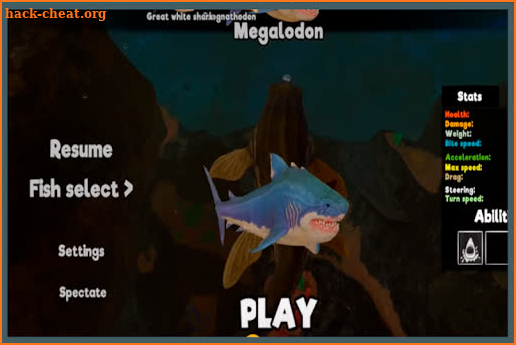Hunt and eat other fish - simply, grow into larger beasts! Animal survival game based in the fish world! You start as Bibos the fish and straight away you are ready to dive in to the waters of the mesmerizing world of Feed and Grow. Growing into more mods and content With the first release we want to test the basics of multiplayer.
CORVALLIS, Ore. – Skip the soil and try growing vegetables in an aquaponics system that turns fish waste into fertilizer for your plants.
'An aquaponics system grows both fish and plants that can be harvested sustainably,' said David Landkamer, an aquaculture specialist with the Oregon State University Sea Grant Extension program. 'It's an elegant system.'
Here's how it works: Fish are typically raised in indoor tanks, troughs or outdoor ponds, where they produce excrement. The water with the waste from the tank flows to a hydroponics tray where plants grow in the water without soil. The waste is toxic to the fish but is a rich fertilizer for the plants. As the plants absorb the nutrients, the water is purified for the fish. The clean water can then be recycled to the fish tank.
Because you can't use pesticides or chemical fertilizers that would harm the fish, it's a natural organic production system.
You can grow just about any kind of plant, Landkamer said. Any leafy greens such as lettuce, kale, Swiss chard and arugula are the easiest to cultivate, he said. You can also grow herbs such as basil, mint and chives. Other crops include cucumbers, shallots, snow peas, eggplant, tomatoes, cabbage, cauliflower, peppers, beans, squash, red onions and even potatoes.
Aquaponics, which began in ancient China and Mexico, is gaining popularity around the world as a means of local food production, Landkamer said. He regularly fields questions from people who want to start small-scale, backyard aquaponics operations or even commercial-scale aquaponics farms. It is possible for hobbyists to start out with aquaponics kits available online and at hydroponics supply stores, Landkamer said.
Aquaponics systems feature a fish tank, trough or outdoors pond and a soil-free bed for plants. The fish container can be made out of fiberglass, glass, concrete or plastic. Containers can range in size from a 20 to 40 gallon plastic tote to a large plastic aquarium about 4 to 5 feet deep and 6 to 10 feet wide. Kits are best suited for a temperature-controlled environment in a greenhouse or inside your home, Landkamer said. Fill the plant bed with pebbles made of clay or gravel, or grow the plants on foam or bamboo 'rafts' that float on the water, Landkamer said.
Beyond the tank and bed, each system relies on the following customizable components: a solids removal area, a biofiltration system to grow helpful bacteria that break down the fish waste, a water sump and pump, and an aeration system. A water sump is a reservoir in which water is collected, and then returned to the rest of the system using a pump.
Depending on which species of fish you choose, you may need to add a heater of some kind to keep the water temperatures just right for the fish and plants. Aquaponics farmers often use inexpensive heat supplies such as solar greenhouses or hot compost, he said.
'These systems require monitoring to make sure everything is in balance and running smoothly,' Landkamer said. 'You have to pay attention and see how well the fish are feeding, how well the plants are growing and see whether the water is circulating properly.'
Besides fish and plants, the aquaponics system naturally produces one other crop – 'good' bacteria that convert the toxic components of fish waste into nutrients that plants can consume. You don't need to add these bacteria, but do get a testing kit to monitor oxygen and nutrient levels in the water, Landkamer said.
Tilapia are the most commonly raised fish in aquaponics systems, he said. Landkamer also recommends catfish, trout, common carp, koi, sunfish, goldfish, barramundi, Murray cod and crayfish. Choose freshwater species, he advised. They can be fed standard diets made for each species and available at feed suppliers or pet stores, he said.
Note that you must purchase a transport permit from the Oregon Department of Fish and Wildlife to raise tilapia and other fish, even for personal use, Landkamer said. These permits are easy to obtain online or from licensed fingerling sellers, he said. ODFW has a list of sellers. Read more information about ODFW's transport permits at their Fish Transport Permit website.

For more information about food safety for fish and plants grown in an aquaponics system, Landkamer recommends a publication from the University of Hawaii at Manoa (PDF). To learn more about aquaponics in general, see this U.S. Department of Agriculture website on aquaponics.

Feed and Grow: Fish Trainer
Feed and Grow: Fish trainer is now available and supports STEAM. These Feed and Grow: Fish cheats are designed to enhance your experience with the game.Options
Change Coins
Change EXP
Change Level
Change Survival Coins
Infinite Energy
Infinite Health
Download Feed and Grow: Fish Trainer 0.9.2a
Game Version: 0.9.2a
Distribution(s): STEAM
Compatibility: Windows 7 and above (may be compatible with additional versions)
Contributor: 0x90
Virus Scan: This cheat has been scanned and is virus and adware free. Some trainers may set off generic or heuristic notifications with certain antivirus or firewall software.
Various Steam Achievements
| Achievement | How to unlock |
|---|---|
|
|
|
|
|
|
|
|
|
|
|
|
|
|
|
|
|
|
|
|
|
|
|
|
How To Get Free Gold In Feed And Grow Fish Online
KNOW SOMETHING WE DON'T?

How To Get Free Gold In Feed And Grow Fish Game
You can submit new cheats for this game and help our users gain an edge.| Print This Page |